Abstract
Understanding the effect surface production has on polymer properties is important in the design of advanced materials. The aim of this study was to determine how the moulding process affected the rate of hydrolysis and the topography, chemistry and physicochemistry of PVAc moulded, hydrolysed surfaces. Three different mould surface materials were used to produce compression moulded PVAc sheets which were treated with aqueous NaOH at a range of concentrations. The Textile moulded sheet demonstrated the best hydrolysis results. The topography of the moulded sheets was transferred to the surfaces and the Kapton release sheet was visually smooth at lower magnification and demonstrated some pitting at higher magnification. The Teflon surface had features transferred from the coated stainless steel at lower magnifications and linear features at higher magnifications and the textile surface had a wrinkled appearance and irregularly spaced peaks. The release sheet used to mould the PVAc surfaces, affected the physicochemical parameters. The Kapton moulded surface demonstrated the most polar attributes and the Teflon surface the most dispersive. It was clear that the selection of the mould material had an influence on surface properties and hydrolysis of moulded PVAc. Such information is important for engineering design in industrial processes.
1. Introduction
Polyvinyl alcohol (PVOH) is used in a number of applications including as surgical threads [1], lacquers [2], resins [3], food packaging materials [4], films with high oxygen-barrier properties [5], paper coatings and liners [6], water soluble films [7], electronics [8], coatings [9], printing [10], cosmetics [11], warp sizing and processing of textile fibres [12], drug delivery [13], contact lenses [14], biomaterials [15] and cements [16]. Given that there is such a wide diversity of applications of PVOH, there is a broad range of surface property characteristics required of the material which is dependent on its specific use and the industrial process in which it is utilised.
Polyvinyl alcohol is made from polyvinyl acetate (PVAc) through alcoholysis which leads to replacement of the acetate groups side groups by hydroxyl groups. Hence, a balance between the amount of vinyl acetate and vinyl alcohol on, or in the copolymer surface needs to be obtained [7]. This can be carried out by treatment with methanol in the presence of an alkali catalyst such as sodium methoxide [17]. The material thus synthesised is a vinylalcohol-rich vinylalcohol–vinylacetate copolymer. Nevertheless, the latter are also commonly referred to as PVOH [5]. In common commercial grades of PVOH, the extent of alcoholysis is typically around 87 to 89%, whilst so-called completely hydrolysed grades have alcoholysis levels of 99 to 100% [18].
Polyvinyl alcohols are thermoplastic polymers that are benign to living tissues, and they are nontoxic, biodegradable and water-soluble which may come in a partially hydrolysed or fully hydrolysed form [19]. The properties of polyvinyl acetate depend on the extent or degree of its hydrolysis, and its degradability is enhanced through hydrolysis because of the presence of hydroxyl groups on the carbon atoms [19]. However, for certain applications, there may be a need for the surface of polyvinyl alcohol to be modified so that it becomes more soluble or insoluble. For example, by manipulating the H-bonding interactions, the intermolecular H bonding is so concentrated it results in fully hydrolysed PVOH becoming insoluble [20,21]. This is of importance since the outermost chemical composition at a polymer surface determines whether the polymer will have good properties with respect to its resistance to biofouling, adhesion to other moieties, biocompatibility, and friction properties [22,23]. The polyvinyl acetate feedstock for PVOH production is usually an atactic polymer and is amorphous due to the large acetate side group, which forces the planar zig-zag conformation of the backbone chain, found in vinyl polymers with small side groups, into a random knobbly helical conformation that is unable to pack into a crystal lattice [18]. Polyvinyl alcohol interestingly is semicrystalline with a crystalline melting point (Tm) of 230 °C [20,21]. Crystallisation is possible due to do the vast reduction in the size of the side group; the OH group is small enough to permit the planar zig-zag conformation and hence allow crystallisation regardless of tacticity [18]. Approximately 80% alcoholysis of PVA is required for the polymer to become semicrystalline [23].
A way to modify a surface it to use different moulding release agents. During the manufacture of polymer parts using compression moulding, release agents or release films are often used for easy removal of the polymer from the mould surface. Using release agents that have different roughness and chemical properties, such as Kapton (a polyimide) or polytetrafluoroethylene (PTFE), the surface textures can result in these being transferred to the moulded polymer surface. The contamination of surface impressions from the release agent surface that results in a deliberate modification of the surface is an interesting way to alter the properties of the moulded films [24].
The aim of this work was to determine the effect of moulding release sheets during the production process of PVAc on the surface roughness and chemistry, and to demonstrate how the differences in surface properties affected the subsequent hydrolysis using an alkaline treatment. This will enable a better understanding of the effect of the moulding process on the surface properties to inform design for industrial processes. The objectives of this work included using a range of moulding release agents to determine how their use affected the hydrolysis, topography, surface features, R values, chemistry, wettability and physicochemistry of the surfaces. Such factors are extremely important in the development of advanced materials.
2. Materials and Methods
2.1. Compression Moulding
Polyvinyl acetate was placed into a steel tray and heated for 30 min at 250 °C before being compression moulded. A hydraulic electrically heated press (Press type 202B-50 ton Bradley and Turton Ltd., UK) with platen temperature set to 220 °C was used for compression moulding. The steel frame mould used to compress the polymers had outside dimensions of 16.3 cm × 19.5 cm, inside dimensions of 8.8 cm × 15.4 cm, and was put in the centre of the release sheets (16.8 cm × 21.8 cm). Two stainless steel sheets (30.2 cm × 23 cm) were placed either side of two release sheets. The stainless steel, plus release sheets, and the mould were placed in the electric press and were pre-heated for five min. Following heating, the sheets were removed from the press and separated, followed by 13.5 g of polymer being spread out in the centre of the mould. The sheets were put back together and the sheets plus polymer were placed in the electric press and left for 10 min. The sample was removed from the press and immediately transferred into a press (#116 Francis Shaw and Company, Manchester, UK) with water cooled platens for 5 min. After cooling the sample was removed and released from the mould.
2.2. Release Material
Several release materials were used to determine how the different moulding processes influenced the surface finish. These included, Kapton polyimide sheet which is a high-quality polyimide film which is uniform in composition and free from defects (DuPont, Mississauga, Ontario USA). The Teflon sheet was a PTFE powder coated stainless steel sheet (cut from a Tesco, UK heavy gauge 38.75 cm × 28 cm × 2 cm oven tray). The Textile release sheet was a plain backed, PTFE impregnated glass textile (PAR, Manchester, UK).
2.3. Production of Surfaces with a Range of Hydrophobicities
The surfaces of the compression moulded sheets were hydrolysed by treatment with varying concentrations of aqueous NaOH, in order to investigate the effect on the components of surface energy. PVOH was cut into 1 cm × 3 cm samples. Samples were treated in sterile distilled water, 1 M, 4 M, and saturated, NaOH solutions for 24 h under continual stirring. Samples were removed from the solution, washed, and soaked for 24 h in sterile distilled water, under continual stirring, in order to minimise the level of sodium acetate contamination. Samples were removed and dried in a class II flow hood.
2.4. Surface Hydrophobicities: Dynamic Contact Angle of Surfaces (Wilhemy Plate Method)
Dynamic contact angle analysis was carried out using a DCA 322-1 dynamic angle analyser (Cahn Instruments, California, USA). Contact angle measurements of clean, dry substrata were taken in HiPerSolv HPLC grade H2O (BDH, Basingstoke, Hampshire, UK) (n = 3).
2.5. Attenuated Total Reflection Fourier Transformation Infra-Red (ATR-FTIR)
ATR-FTIR was carried out using a Silicon ATR objective fitted to a Thermo-Nicolet Continuum FTIR microscope using an A-Type MCT detector. Spectra were made up of 240 scans with resolution of 4 cm−1. As the sampling area of the microscope ATR—FTIR was 200 μm × 200 μm, multiple spectra were run on a given surface and the average spectrum of five replicates was reported. All spectra were corrected to accommodate variation in penetration depth with wavelength (n = 3).
2.6. Determination of Surface Roughness and Topography Using Atomic Force Microscopy (AFM)
Substrata images and roughness measurements were obtained using an Explorer AFM. Analysis was carried out in contact mode using a cantilever with a spring constant of 0.12 N m−1 (n = 3).
2.7. Scanning Electron Microscopy (SEM)
The samples were gold sputter coated using a SEM sputter coater (Polaron E5100, UK). Samples were sputter coated at a vacuum of 0.09 mbar, for 3 min, at 2500 V, in argon gas at a power of 18–20 mA. Images of substrata were obtained using a JEOL JSM 5600LV scanning electron microscope (n = 3).
2.8. Statistical Analysis
Data was statistically evaluated using T tests whereby the confidence level was 95% (p < 0.05).
3. Results
PVAc was compression moulded against a range of different release sheets and was treated with different concentrations of NaOH to determine how the surface properties of the materials, were affected. ATR-FTIR was used to chemically characterise the surfaces following moulding (Figure 1). It was demonstrated that using ATR-FTIR the PVAc demonstrated a methylene asymmetric CH–H stretching band at 2987 cm−1 and a C–H broad alkyl stretching band at 2850 cm−1. At ca. 1741 cm−1, an acetone carbonyl (C=O) stretching vibration was detected whilst at 1418 cm−1 and 1329 cm−1 O–H bending coupled C–H vibrations were determined. Finally, a C(=O)–O stretching band was detected at 1230 cm−1 and a C–O stretching band was determined at 1092 cm−1.
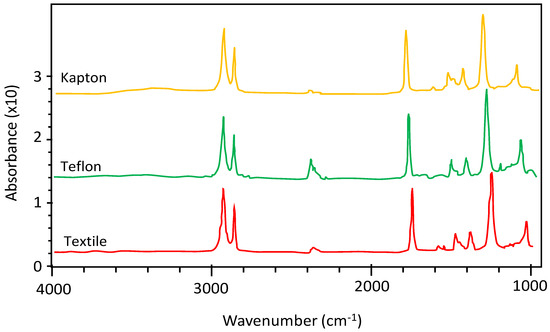
Figure 1.
ATR-FTIR determination of the chemical bonds on the surfaces.
The absorbance ratio of the methylene C-H asymmetric stretch (Abs(CH-H)as, (at 2987 cm−1)) to the acetate carbonyl (Abs(C=O), (at ca. 1741 cm−1)) provided information representing the relative level of hydrolysis of the surfaces whereby an increase in the ratio indicated less acetate carbonyl and hence a higher level of hydrolysis (Figure 2). Note that as an absorbance ratio was used there was no need to normalise the spectra to a specific absorption peak; in this case the methylene C-H asymmetric stretching band was the internal standard. The experimental error for the Abs(CH-H)as / Abs(C=O) was ± 5% of the value recorded. The results demonstrated that surfaces moulded against Kapton or Teflon sheets showed treatment with increasingly concentrated NaOH gave rise to no significant difference in extent of hydrolysis, relative to the control surface. However, a subtle trend was observed in that the mould surface affected the measured level of hydrolysis. The Kapton sheet gave a surface hydrolysis level of 1.4 for the control, whilst treatment with saturated NaOH increased the hydrolysis level to 1.8. In contrast, the Teflon sheet gave a hydrolysis level of 2.6 for the control and 2.8 after treatment with saturated NaOH. On sheets moulded against the Textile release film, there was a significant increase in the amount of hydrolysis demonstrated between the control sheet (2.4) and the sheet treated with the saturated sodium hydroxide (3.4). In summary, to obtain the maximum hydrolysis using the release sheets tested in these assays, the Textile sheet demonstrated the best results.
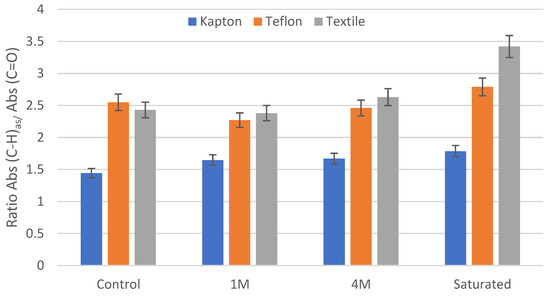
Figure 2.
Hydrolysis of the moulded PVOH surfaces treated with NaOH demonstrating the changes in surface hydrolysis.
Following production, the surfaces were analysed in terms of their macro- (light microscopy) and micro-topographies (SEM and AFM). The control and surfaces treated with concentrated NaOH are shown for comparison. Using light microscopy (Figure 3), it was demonstrated that in all cases that the pattern of the topography of the release sheet was transferred onto the moulded film. On the Kapton surface (Figure 3A), following treatment there was a different more patterned topography demonstrated (Figure 3B). This change in topography was most evident with the Teflon release film (Figure 3C), whereby the pattern of the underlying steel was clearly transferred to the surface of the moulded films (Figure 3D), and the pattern looked more pronounced on the moulded film treated in saturated NaOH. On the moulded film produced using the Textile release sheet, there were clear striations across the surface that had transferred from the moulded sheet (Figure 3E), but in contrast to the surfaces produced using the other release sheets, the surface treated with saturated NaOH, looked to have less pronounced surface features (Figure 3F). Hence, using light microscopy, it was clear that the topography of the moulded sheets was transferred to the surfaces and that the effect was most pronounced for the Teflon release sheet produced surface.
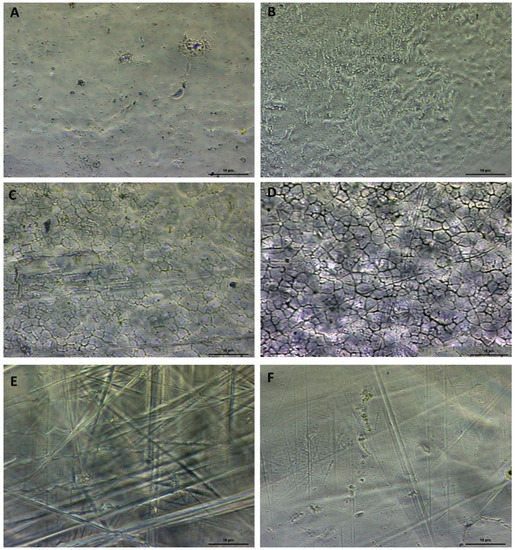
Figure 3.
Light microscopy of the surfaces following compression moulding using the release sheet (A,B) Kapton (C,D) Teflon and (E,F) Textile. The control (A,C,E) and surfaces following treatment in saturated NaOH (B,D,F).
To observe in greater detail how the moulding sheets affected the topography of the surfaces, scanning electron microscopy was used at higher magnification (Figure 4). The control and surfaces treated with concentrated NaOH were illustrated. It was demonstrated that following treatment with the concentrated NaOH and compared to the control (Figure 4A,C), the Kapton (Figure 4B) and Teflon (Figure 4D) moulded surfaces were visually smoother. However, when compared to the non-hydrolysed surface (Figure 4E) a wrinkled effect was visualised following treatment of the Textile moulded surfaces with concentrated NaOH (Figure 4F). Using higher magnification, the surface topographies following NaOH treatment demonstrated different topographies than those observed using light microscopy.
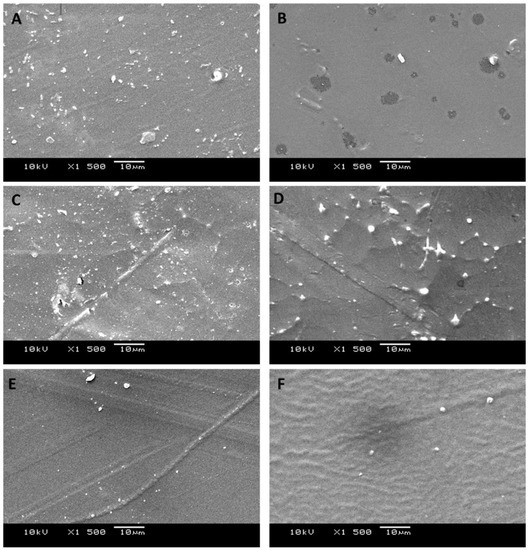
Figure 4.
SEM of the surfaces following compression moulding using the release sheet (A,B) Kapton (C,D) Teflon and (E,F) Textile. The control (A,C,E) and surfaces following treatment in saturated NaOH (B,D,F) are shown.
AFM was used to further determine the surface features and topographies. The control and surfaces treated with concentrated NaOH were illustrated for comparison. On the Kapton moulded surface, the surface topographies agreed with those seen at the macro scale using SEM, whereby the surface topography on the control surface (Figure 5A) was rougher than surface treated with concentrated NaOH (Figure 5B). The untreated Kapton moulded surface also demonstrated some pitting. On the Teflon and Textile treated surfaces, the surface topographies looked very similar pre- and post NaOH treatment (Figure 5C,E and Figure 5D,F respectively). There were clearly linear features on the Teflon surface, whilst the Textile moulded surface displayed irregularly formed and distributed peaks. In summary, AFM showed that the Kapton surface demonstrated some pitting, the Teflon surface had linear features and the textile surface had irregularly spaced peaks.
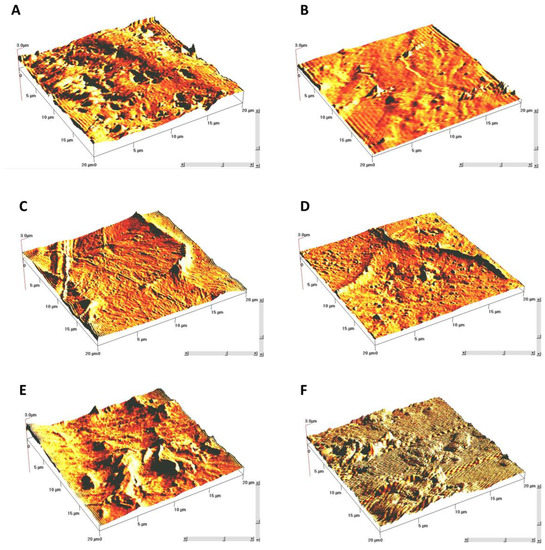
Figure 5.
AFM 3D maps (20 µm × 20 µm) of the surfaces following compression moulding using the release sheet (A,B) Kapton (C,D) Teflon and (E,F) Textile. The control (A,C,E) and surfaces following treatment in saturated NaOH (B,D,F) are shown. Z height = 3 µm.
Surface line profiles were taken of the surfaces to determine the shape of the surface features (Figure 6). The control and surfaces treated with concentrated NaOH were shown. The Kapton moulded surfaces (Figure 6A control and Figure 6B NaOH treated) demonstrated surface features that were wider than the Teflon (Figure 6C control and Figure 6D NaOH treated) or Textile (Figure 6E control and Figure 6F NaOH treated) moulded surfaces. However, the waviness of the features observed in the SEM images was clearly apparent in the linear profile for the Textile moulded surface treated with saturated NaOH.
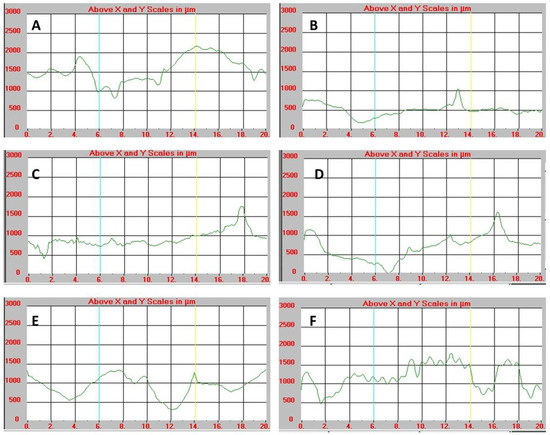
Figure 6.
AFM line profiles (20 µm) of the surfaces following compression moulding using the release sheet (A,B) Kapton (C,D) Teflon and (E,F) Textile. The control (A,C,E) and surfaces following treatment in saturated NaOH (B,D,F) are shown. Z height = 3 µm.
The sizes of the valley depth and width and peak height and width of the Kapton, Teflon and Textile moulded surfaces was quantified (Table 1). The results demonstrated that the surface moulded using the Kapton release agent demonstrated the largest valley depths (6 µm–60 µm) and widths (23 µm–49 µm), with high (10 µm–70 µm) and wide peaks (9 µm–50 µm) demonstrating an undulating profile. Overall, the surface moulded using the Textile release agent demonstrated the smallest valley depths (0.25 µm–2 µm) and widths (0.5 µm–3 µm), with small peak heights (6 µm–25 µm) demonstrating a more topographically ‘spikey’ surface. Overall, the linear profiles demonstrated that the surface produced using the Kapton release material produced the widest, most undulating topographical features with pits, the Teflon release sheet produced peaks and valleys that were of similar dimensions and the textile surface had a regular wrinkled pattern.

Table 1.
Maximum and minimum valley depth and width and Maximum and minimum peak height and width of the Kapton, Teflon and Textile moulded surfaces, untreated (control) and treated with 1M, 4M and concentrated (Conc.) NaOH.
The Ra (the arithmetic average of the absolute values of the profile height deviations from the mean line, recorded within the evaluation length) (Figure 7A) and Rz (average value of the absolute values of the heights of five highest-profile peaks and the depths of five deepest alleys within the evaluation length) (Figure 7B) of the surfaces were quantified to determine the surface roughness. As treatment of the surface treatment with NaOH increased on the Kapton moulded surface, the Ra (442.8 nm–63.4 nm) (Figure 7A) and Rz values (3.59–1.49) (Figure 7B) significantly decreased. For the Teflon moulded surfaces, the trend was not clear, with the 4M NaOH treated surfaces demonstrating the highest values and the 1M NaOH treated surfaces demonstrating the lowest values (Ra 424.6 nm–183.7 nm and Rz 3.19 µm and 2.32 µm respectively). On the Textile moulded surfaces, as treatment of the surfaces with NaOH increased, the Ra value generally increased, with the exception of the control surface (115.4 nm–21.1 nm). The Rz values demonstrated that with the 4 M NaOH treated surfaces the highest values were demonstrated, whilst with the 1M NaOH treated surfaces the lowest values were found (Rz 2.5 µm and 1.0 µm). In summary, the use of Ra was beneficial for the surfaces using the Kapton and Textile surfaces which demonstrated opposing trends, whilst Rz only demonstrated trends with the surfaces produced using the Kapton release sheets.
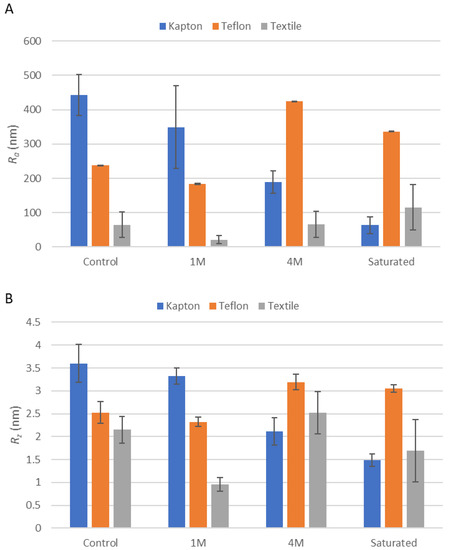
Figure 7.
(A) Ra and (B) Rz values of the surfaces following compression moulding using the release sheet Kapton, Teflon and Textile and following treatment with water (control) and 1 M, 4 M and saturated NaOH.
To determine the physicochemical effect of the different moulding and NaOH treatment of the surfaces, the water contact angle (Figure 8A), surface free energy (Figure 8B), polar (Figure 8C) and dispersive (Figure 8D) components of the surfaces was calculated. For all the differently moulded surfaces, the contact angle decreased with treatment with increasing NaOH molarity treatments (control and saturated = Kapton 99.2°–68.3°; Teflon 98.0°–83.8°; Textile 93.9°–83.7° (4 M NaOH)) (Figure 8A). The opposite trend was demonstrated with the surface free energies whereby for all the differently moulded surfaces, the surface free energy increased with treatment with increasing NaOH molarity solutions (control and saturated = Kapton 26.9 mN/m–39.2 mN/m; Teflon 26.4 mN/m–33.2 mN/m; Textile 26.4 mN/m–31.5 mN/m) (Figure 8B). The polar components gave the most variation in results. The Kapton surface demonstrated the most significant changes in the polar components of the surface where the polar component significantly increased with treatment with increasiing NaOH molarity solutions (control and saturated = 0.9 mN/m–13.8 mN/m). Both the Teflon and Textile moulded surfaces also increased in polar components, but not to such an extent as the Kapton surface, and the greatest Textile polar component was demonstrated on the 4M treated surface (Teflon 2.7 mN/m–5.0 mN/m; Textile 2.3 mN/m–5.28 mN/m (4M NaOH)) (Figure 8C). The dispersive components of the surfaces demonstrated no significant differences in the surfaces with increasing NaOH treatment although the Teflon moulded surface demonstrated the most difference, followed by the Textile moulded surface and finally the Kapton moulded surface (control and saturated = Kapton 26.0 mN/m–25.5 mN/m; Teflon 23.6 mN/m–28.1 mN/m; Textile 24.1 mN/m–26.8 mN/m) (Figure 8D). Hence, the results demonstrated that the release sheet used to mould the PVAc surfaces, and their subsequent hydrolysis affected the physicochemical parameters.
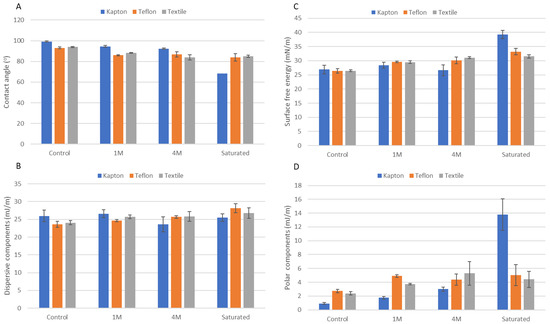
Figure 8.
(A) Water contact angle, (B) surface free energy (C) polar components and (D) dispersive components of the surfaces following compression moulding using the release sheet Kapton, Teflon and Textile and following treatment with water (control) and 1 M, 4 M and saturated NaOH.
4. Discussion
Polymers for use in a range of different environments has been widely explored, yet an accurate understanding of the relationship between the use of different release sheets used in their production on the surface roughness, physicochemistry and extent of hydrolysis has not yet been achieved. The need for understanding the processing parameters on material properties such as surface topography and wettability is of primary importance when aiming to design advanced functional materials [25].
4.1. Surface Analysis and Hydrolysis
ATR-FTIR was used to determine the chemical bonds on the surfaces following production using the different release sheets. It was demonstrated that the expected spectra were obtained [26,27]. The physical characteristics of the hydrolysed surfaces depended on both the degree of polymerisation and the degree of hydrolysis of the acetate groups [28]. In this study, three different types of release agents were used to produce PVAc sheets, which were then subjected to NaOH treatment to increase the hydrolysis of the surfaces. This concept was investigated since the modification of PVOH may be useful for surfaces that require the use of such a non-toxic material. PVOH is a biodegradable polymer, and its degradability is enhanced through hydrolysis because of the presence of hydroxyl groups on the carbon atoms [18]. PVOH surfaces with different hydrolysis standards, will solubilise at different rates and the diversity in the hydrolysis rates may be of advantage for certain applications. For example, the abundance of hydroxyl groups along the backbone enables macromers to be readily modified with reactive chemistries for photopolymerization [29]. Following hydrolysis, if all the acetate groups are converted to OH groups, then fully hydrolysed PVOH is obtained, however, if a proportion of acetate groups remain, the result is partially hydrolysed PVOH [7]. A high content of hydroxyl groups decreases the solubility in water due to increased crystalline content, due to increased hydrogen bonding between the polymer molecules in the crystalline state [7]. Overall, this study demonstrated that treatment of the PVAc surfaces with increased concentrations of NaOH, increased the hydrolysis of the surfaces, however, the effect was most pronounced on the surface produced using the Textile mould surface, and least on the surfaces produced using the other release agents. Thus, if maximal hydrolysis is required on the surface following treatment with NaOH, the Textile release agent was the best to use. The reason behind the results for the Textile release sheet may be explained possibly due to the differences in the surface chemistries and topographies of the release sheets. Teflon is Polytetrafluoroethylene (PTFE) and can be used as a powder coating which is sprayed onto a surface forming a covering. It can also be impregnated into a matrix, for example in the woven glass fibres of the Textile mould surface release sheets. When the surface properties of the two PTFE release sheets (Teflon and Textile) were considered, although they had the same surface chemistry, they varied in the pattern of their surface roughness. The PVAc moulded against Textile demonstrated that both Ra and extent of hydrolysis increased as NaOH treatment concentration increased, whereas the same trend was not observed on the PVAc moulded against the Teflon. This may suggest that the pattern of the surface topography influenced the amount of hydrolysis on the surfaces.
In contrast, the surface linear roughness profiles of the surface moulded using the Kapton release agent demonstrated the largest valley depths and width, with high and wide peaks demonstrating an undulating profile and the least hydrolysis. The surface produced using the Kapton release sheet also became smoother with treatment with increasing NaOH concentration with both Ra and Rz values decreasing. Overall, the surface moulded using the Textile release agent demonstrated the smallest valley depths and width, with small peak heights demonstrating a more topographically ‘spikey’ surface. It may be that the potential increased surface area of the Teflon and Textile moulded PVAc enabled greater hydrolysis of the surfaces with increasing NaOH treatment.
The chemistry of the release material used may also have influenced the amount of hydrolysis that occurred on the surfaces since it is possible that the PTFE used as a matrix for the glass fibre textile was more robust (higher average molar mass) than the powder coated steel sheet. This might occur since for the steel sheet to have been powder coated with PTFE, the molar mass of the powder particles will need to be low in order for them to sinter at zero shear. The PTFE matrix for the textile, on the other hand, may have been roll impregnated into the glass cloth under pressure, and thus higher molar mass PTFE may have been used. This could result in the potential transfer of minute chemical moieties from the PTFE coated onto the stainless sheet surface onto the PVAc. This would result in decreased hydrolysis of the surface.
4.2. Surface Topography
A range of different methods were carried out to characterise the surface topographies of the surfaces following moulding and treatment. On surface produced using the Kapton release sheet, the macro topography of the surface was more pronounced, with a smoother microtopography which contained some pitting, and such surface defects may be detrimental for use of a surface moulded in this way to be used. The physicochemical properties of Kapton may have enabled the PVAc in parts to stick to it resulting in the pitting features observed. On the surface produced using the Teflon release sheet, the macro topography was the most pronounced of the three surfaces tested, whilst the surfaces produced using the Textile less pronounced macro, but a wrinkled topography was demonstrated on the surface treated with the saturated NaOH. Hence, it was clear that the use of the different release sheets used to produce the PVAc surfaces altered the topography and roughness of the final moulded sheets and such alterations in surface topographies may be important depending on the intended final application of the material. This is of importance since it is widely known that the topography of a surface can affect the retention of microbial species [26,30,31] which can lead to increased biofouling and/or biodeterioration [32].
4.3. Surface Physicochemistry
The physicochemistry of the surfaces was used to determine if using the different moulded release sheets demonstrated any significant effect on the wettability, surface free energy, polar and dispersive components of the surfaces. It was demonstrated that the contact angle of the surfaces decreased with increasing NaOH treatment on the surfaces produced using the Kapton release sheet, whilst the surface free energy and polar component significantly increased with surface treatment using increased concentrations of NaOH. This suggested that use of the Kapton release sheet would be beneficial if more wettable surfaces were required. For example, the hydrophilicity and processing characteristics allow polymers such as PVOH to be mixed with other natural and artificial polymers [18,33,34] and used extensively in the medical field [35,36,37,38,39,40].
When designing surfaces with desirable wettability, the surface patterning is of great importance [25]. The results showed that an increase in surface free energy and polarity corresponded with the decrease in contact angle, Ra and Rz values. The Kapton moulded surface also had the lowest extent of hydrolysis. Such modifications can be advantageous since it has been shown that PVOH polymers with more reactive functional groups and a higher surface energy, produce a surface with increased wettability and more possibilities for the creation of intermolecular interactions which can result in improved adhesion strength [24]. On the surfaces produced using the Teflon release sheets, although the contact angle decreased and the polar components and the surface free energy increased with increasing NaOH concentration, the effects were less pronounced than on the surfaces produced using the Kapton release sheets. The dispersive component of the surfaces was most pronounced on the surfaces produced using the Teflon release sheet. This high dispersive result might have been due to leaching of chemical components from the PTFE surfaces. Although PTFE is known for its inertness, [41] low levels of residual monomer, oligomers, and low molecular weight leachables can migrate out of the polymer [42]. In addition, the rise in temperature PTFE resin produces pyrolytic gases [43]. Perfluoroalkanes, octofluoroisobutylene, tetrafluoroethylene, hexafluoropropylene, octofluorocyclobutane, carbonyl fluoride and trifluoroacetyl fluoride have been identified as leachates from PTFE [44]. Tetrafluoroethylene and hexafluoropropylene have also been detected to be released in lower quantities from PTFE [14]. The transfer of such molecules could result in changes in the surface physicochemistries, and this is of importance since the final finish, texture and chemistry of the surface determines the wearability, lubrication, fatigue resistance, and external appearance of the material [45]. Further, alterations to the surface of a polymer can result in performance limitations which can affect their practical application since polymeric surfaces, in general, present nonpolar characteristics, which imply low affinity for a wide range of compounds, especially those of water-based and polar nature [45], although this outcome may be beneficial for some applications. In this study, it was demonstrated that the Teflon and Textile moulded surfaces produced the most dispersive characteristics and were the least polar. By modifying their surface properties, polymers provide a promising strategy to significantly improve their physical properties [4].
5. Conclusions
PVAc surfaces were moulded using different release sheets and then treated with NaOH to determine the effect of the sheets on the surface properties and rates of hydrolysis so as to provide information for the development of advanced materials. It was clear that the selection of the mould surface material had an important influence on the modification of surface properties and hydrolysis of moulded PVOH. To obtain the maximum hydrolysis using the release sheets tested in these assays, the Textile sheet demonstrated the best results. The topography of the moulded sheets was transferred to the surfaces and that the effect was most pronounced for the Kapton release sheet produced surface, which at higher magnification demonstrated some pitting. The Teflon surface had linear features and the textile surface had irregularly spaced peaks and a wrinkled appearance. The use of Ra was beneficial for the surfaces using the Kapton and Textile surfaces which demonstrated opposing trends, whilst Rz only demonstrated trends with the surfaces produced using the Kapton release sheets. It was further determined that the release sheet used to mould the PVAc surfaces, affected the physicochemical parameters and extent of hydrolysis. Thus, the selection of the moulding sheet used in the production of polymer surfaces should be given due consideration to ensure the optimal surface properties for advanced material design is achieved.
Author Contributions
The concept behind the work was developed by T.D., C.M.L., J.V. and K.A.W. The experimental methodology was developed and carried out by K.A.W. and C.M.L. The manuscript was written by M.A. and K.A.W. All the authors were involved in the final proofing of the manuscript. All authors have read and agreed to the published version of the manuscript.
Funding
This work was funded by BASF Inc. (previously Ciba Specialty Chemicals Inc., Germany).
Data Availability Statement
Original/source data for the figures and data in the paper is available from the lead contact. Processed data are supplied and can be accessed from MMU e-space (https://espace.mmu.ac.uk/629087/, accessed on 25 September 2022).
Conflicts of Interest
The authors declare no conflict of interest.
References
- Razumova, L.L.; Veretennikova, A.A.; Zaikov, G.Y.; Volf, L.A. Degradation of polyvinyl alcohol surgical thread. Polym. Sci. U.S.S.R. 1983, 25, 2418–2425. [Google Scholar] [CrossRef]
- Webb, M. Methods and materials for filling losses on lacquer objects. J. Am. Inst. Conserv. 1998, 37, 117–133. [Google Scholar] [CrossRef]
- Montero, J.; Vitale, P.; Weber, S.; Bleckmann, M.; Paetzold, K. Indirect Additive Manufacturing of resin components using polyvinyl alcohol sacrificial moulds. Procedia CIRP 2020, 91, 388–395. [Google Scholar] [CrossRef]
- Apicella, A.; Barbato, A.; Garofalo, E.; Incarnato, L.; Scarfato, P. Effect of PVOH/PLA + Wax Coatings on Physical and Functional Properties of Biodegradable Food Packaging Films. Polymers 2022, 14, 935. [Google Scholar] [CrossRef] [PubMed]
- Jain, N.; Singh, V.K.; Chauhan, S. A review on mechanical and water absorption properties of polyvinyl alcohol based composites/films. J. Mech. Behav. Mater. 2017, 26, 213–222. [Google Scholar] [CrossRef]
- Finley, J.H. Spectrophotometric determination of alcohol in paper coatings. Anal. Chem. 1961, 33, 1925–1927. [Google Scholar] [CrossRef]
- Byrne, D.; Boeije, G.; Croft, I.; Hüttmann, G.; Luijkx, G.; Meier, F.; Parulekar, Y.; Stijntjes, G. Biodegradability of polyvinyl alcohol based film used for liquid detergent capsules. Tenside Surfactants Detetergents 2021, 58, 2. [Google Scholar] [CrossRef]
- Van Etten, E.A.; Ximenes, E.S.; Tarasconi, L.T.; Garcia, I.T.S.; Forte, M.M.C.; Boudinov, H. Insulating characteristics of polyvinyl alcohol for integrated electronics. Thin Solid Film. 2014, 568, 111–116. [Google Scholar] [CrossRef]
- Vetter, P.; Ohmura, Y.; Uchida, T. Study of memory alignment of nematic liquid crystals on polyvinyl alcohol coatings. Jpn. J. Appl. Phys. 1993, 32, L1239. [Google Scholar] [CrossRef]
- Schaper, C.D.; Miahnahri, A. Polyvinyl alcohol templates for low cost, high resolution, complex printing. J. Vac. Sci. Technol. B Microelectron. Nanometer Struct. Process. Meas. Phenom. 2004, 22, 3323. [Google Scholar] [CrossRef]
- Burnett, C.L. Polyvinyl Alcohol. Int. J. Toxicol. 2017, 36, 2. [Google Scholar] [CrossRef]
- Sakurada, I. Polyvinyl Alcohol Fibers; Marcel Dekker: New York, NY, USA; Basel, Switzerland, 1985. [Google Scholar]
- Kaity, S.; Isaac, J.; Ghosh, A. Interpenetrating polymer network of locust bean gum-poly (vinyl alcohol) for controlled release drug delivery. Carbohydr. Polym. 2013, 94, 456–467. [Google Scholar] [CrossRef] [PubMed]
- Hyon, S.H.; Cha, W.I.; Ikada, Y.; Kita, M.; Ogura, Y.; Honda, Y. Poly (vinyl alcohol) hydrogels as soft contact lens material. J. Biomater. Sci. Polym. Ed. 1994, 5, 397–406. [Google Scholar] [CrossRef] [PubMed]
- Muggli, D.S.; Burkoth, A.K.; Anseth, K.S. Crosslinked polyanhydrides for use in orthopedic applications: Degradation behavior and mechanics. J. Biomed. Mater. Res. 1999, 46, 271–278. [Google Scholar] [CrossRef]
- Thong, C.C.; Teo, D.C.L.; Ng, C.K. Application of polyvinyl alcohol (PVA) in cement-based composite materials: A review of its engineering properties and microstructure behaviour. Constr. Build. Mater. 2016, 107, 172–180. [Google Scholar] [CrossRef]
- Aruldass, S. Hydrolysis of polyvinyl acetate into polyvinyl alcohol. Res. Commun. Eng. Sci. Technol. 2019, 3, 10. [Google Scholar]
- Brydson, J.A. Plastics Materials, 4th ed.; Butterworth Scientific: London, UK, 1985; p. 355. ISBN 0-408-00538. [Google Scholar]
- Gaaz, T.S.; Sulong, A.B.; Akhtar, M.N.; Kadhum, A.A.; Mohamad, A.B.; Al-Amiery, A.A. Properties and applications of polyvinyl alcohol, halloysite nanotubes and their nanocomposites. Molecules 2015, 19, 22833–22847. [Google Scholar] [CrossRef]
- Kuraray. Basic Physical Properties of PVOH. Available online: https://www.kuraray-poval.com/fileadmin/technical_information/brochures/poval/kuraray_poval_basic_physical_properties_web.pdf (accessed on 25 August 2022).
- Saunders, K.J. Organic Polymer Chemistry; Chapman and Hall: London, UK, 1985; p. 111. ISBN 0-412-10580. [Google Scholar]
- Chihani, T.; Bergmark, P.; Flodin, P.; Hjertberg, T. Surface properties of an anhydride-epoxy resin cured against different mould surfaces. J. Adhes. Technol. 1993, 7, 569–582. [Google Scholar] [CrossRef]
- Chihani, T.; Bergmark, P.; Flodin, P. Surface modification of ethylene copolymers molded against different mold surfaces. Part 2. Changes at the outermost surface. J. Adhes. Technol. 1993, 7, 327–341. [Google Scholar] [CrossRef]
- Chihani, T.; Chihani, P.; Flodin, P.; Hjettberg, T. Modification of epoxy surfaces with different polyvinylalcohol polymers. J. Appl. Polym. Sci. 1993, 50, 1343–1350. [Google Scholar] [CrossRef]
- Kavousanakis, M.E.; Chamakos, N.T.; Papathanasiou, A.G. Connection of intrinsic wettability and surface topography with the apparent wetting behavior and adhesion properties. J. Phys. Chem. C 2015, 119, 15056–15066. [Google Scholar] [CrossRef]
- Liauw, C.M.; Deisenroth, T.; Preuss, A.; Verran, J.; Whitehead, K.A. The effect of polyvinyl acetate and polyvinyl alcohol on the attachment, adhesion and retention of fungal spores. J. Polym. Environ. 2020, 28, 1450–1464. [Google Scholar] [CrossRef]
- dos Reis, E.F.; Campos, F.S.; Lage, A.P.; Leite, R.C.; Heneine, L.G.; Vasconcelos, W.L.; Lobato, Z.I.P.; Mansur, H.S. Synthesis and characterization of Poly (Vinyl Alcohol) hydrogels and hybrids for rMPB70 protein adsorption. Mater. Res. 2006, 9, 185–191. [Google Scholar] [CrossRef]
- Roberts, J.J.; Martens, P.J. Chapter 9 Engineering biosynthetic cell encapsulation systems. In Biosynthetic Polymers for Medical Applications; Woodhead Publishing Series in Biomaterials; Woodhead Publishing: Cambridge, UK, 2016; pp. 205–239. [Google Scholar]
- Guvendiren, M.; Purcell, B.; Burdick, J.A. Chapter 9.22 Photopolymerizable systems. Polym. Sci. A Compr. Ref. 2012, 9, 413–438. [Google Scholar]
- Whitehead, K.A.; Verran, J. The effect of surface topography on the retention of microorganisms: A review. Food Bioprod. Process. 2006, 84, 253–259. [Google Scholar] [CrossRef]
- Yuan, Y.; Hays, M.P.; Hardwidge, P.R.; Kim, J. Surface characteristics influencing bacterial adhesion to polymeric substrates. RSC Adv. 2017, 7, 14254–14261. [Google Scholar] [CrossRef]
- Whitehead, K.A.; Verran, J. The Effect of Substratum Properties on the Survival of Attached Microorganisms on Inert Surfaces. In Marine and Industrial Biofouling; Flemming, H.-C., Venkatesan, R., Murthy, P.S., Cooksey, K., Eds.; Springer Series on Biofilms Springer: Cham, Germany, 2009; pp. 13–33. [Google Scholar]
- Lee, H.; Mensire, R.; Cohen, R.E.; Rubner, M.F. Strategies for hydrogen bonding based layer-by-layer assembly of poly (vinyl alcohol) with weak polyacids. Macromolecules 2011, 45, 347–355. [Google Scholar] [CrossRef]
- Fujii, K.; Nakagaito, A.N.; Takagi, H.; Yonekura, D. Sulfuric acid treatment of halloysite nanoclay to improve the mechanical properties of PVA/halloysite transparent composite films. Compos. Interfaces 2014, 21, 319–327. [Google Scholar] [CrossRef]
- Lvov, Y.; Abdullayev, E. Functional polymer-clay nanotube composites with sustained release of chemical agents. Prog. Polym. Sci. 2013, 38, 1690–1719. [Google Scholar] [CrossRef]
- Zhou, W.Y.; Guo, B.; Liu, M.; Liao, R.; Rabie, A.B.; Jia, D. Poly (vinyl alcohol)/halloysite nanotubes bionanocomposite films: Properties and in vitro osteoblasts and fibroblasts response. J. Biomed. Mater. Res. A 2010, 93, 1574–1587. [Google Scholar] [CrossRef]
- Jang, J.; Lee, D.K. Plasticizer effect on the melting and crystallization behavior of polyvinyl alcohol. Polymer 2003, 44, 8139–8146. [Google Scholar] [CrossRef]
- Fernandes, E.M.; Pires, R.A.; Mano, J.F.; Reis, R.L. Bionanocomposites from lignocellulosic resources: Properties, applications and future trends for their use in the biomedical field. Prog. Polym. Sci. 2013, 38, 1415–1441. [Google Scholar] [CrossRef]
- Jayasekara, R.; Harding, I.; Bowater, I.; Christie, G.B.; Lonergan, G.T. Preparation, surface modification and characterisation of solution cast starch PVA blended films. Polym. Test. 2004, 23, 17–27. [Google Scholar] [CrossRef]
- Heuschmid, F.F.; Schuster, P.; Lauer, B.; Fabian, E.; Leibold, E.; Ravenzwaay, B.V. Polyethylene glycol-polyvinyl alcohol grafted copolymer: Study of the bioavailability after oral administration to rats. Food Chem. Toxicol. 2013, 51, S3–S6. [Google Scholar] [CrossRef]
- Ebnesajjad, S. Introduction to fluoropolymers. In Applied Plastics Engineering Handbook; Kutz, M., Ed.; Elsevier: New York, NY, USA, 2011; pp. 49–60. [Google Scholar]
- Henry, B.J.; Carlin, J.P.; Hammerschmidt, J.A.; Buck, R.C.; Buxton, L.W.; Fiedler, H.; Seed, J.; Hernandez, O. A critical review of the application of polymer of low concern and regulatory criteria to fluoropolymers. Integr. Environ. Assess. Manag. 2018, 14, 316–334. [Google Scholar] [CrossRef]
- Sajid, M.; Ilyas, M. PTFE-coated non-stick cookware and toxicity concerns: A perspective. Environ. Sci. Pollut. Res. Int. 2017, 24, 23436–23440. [Google Scholar] [CrossRef]
- Artto, H.; Soda, R. Pyrolysis products of polytetrafluoroethylene and polyfluoroethylenepropylene with reference to inhalation toxicity. Annu. Occup. Hyg. 1977, 20, 247–253. [Google Scholar]
- Encinas, N.; Pantoja, M.; Abenojar, J.; Martínez, M.A. Control of wettability of polymers by surface roughness modification. J. Adhes. Sci. Technol. 2010, 24, 1869–1883. [Google Scholar] [CrossRef]
Publisher’s Note: MDPI stays neutral with regard to jurisdictional claims in published maps and institutional affiliations. |
© 2022 by the authors. Licensee MDPI, Basel, Switzerland. This article is an open access article distributed under the terms and conditions of the Creative Commons Attribution (CC BY) license (https://creativecommons.org/licenses/by/4.0/).